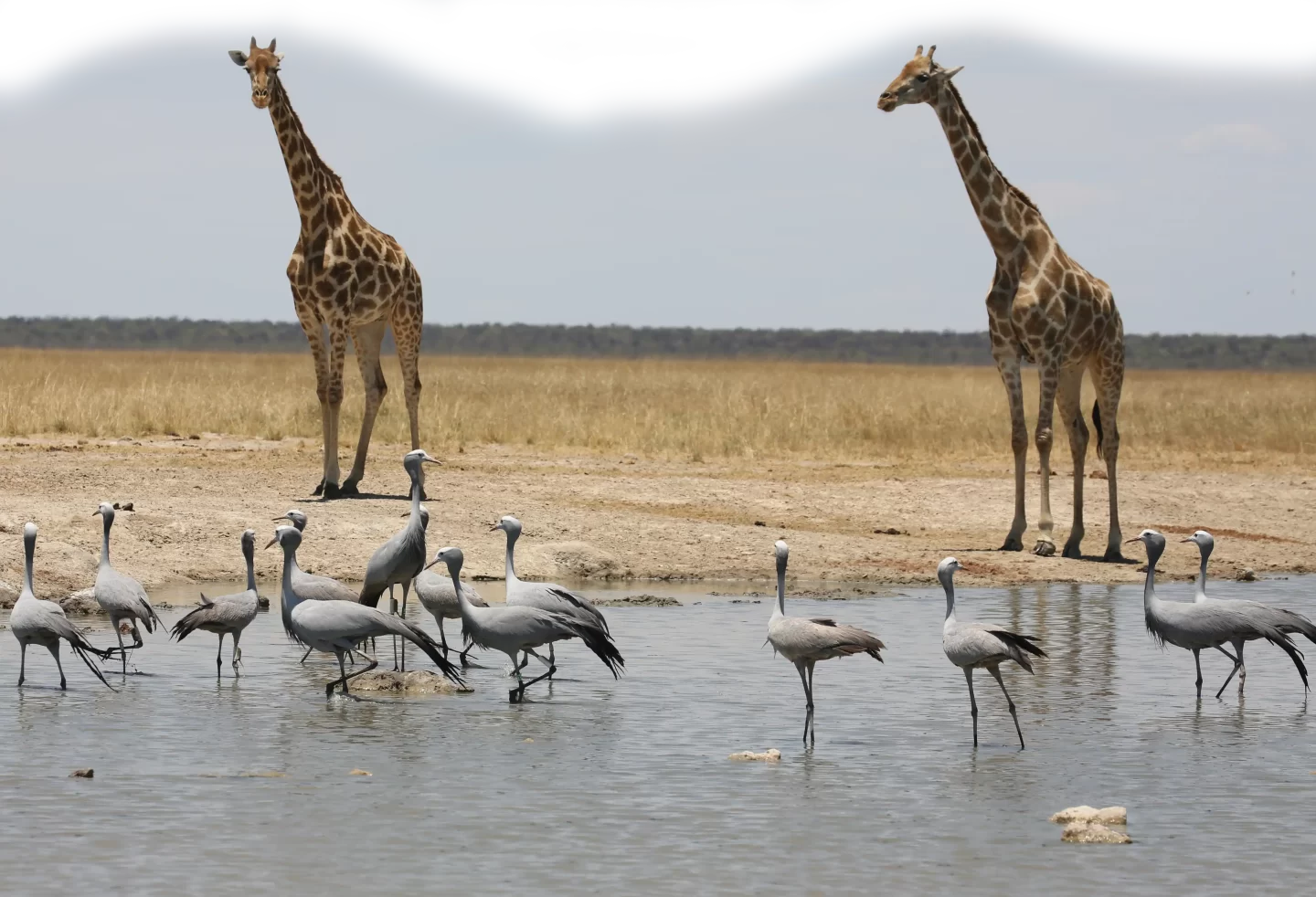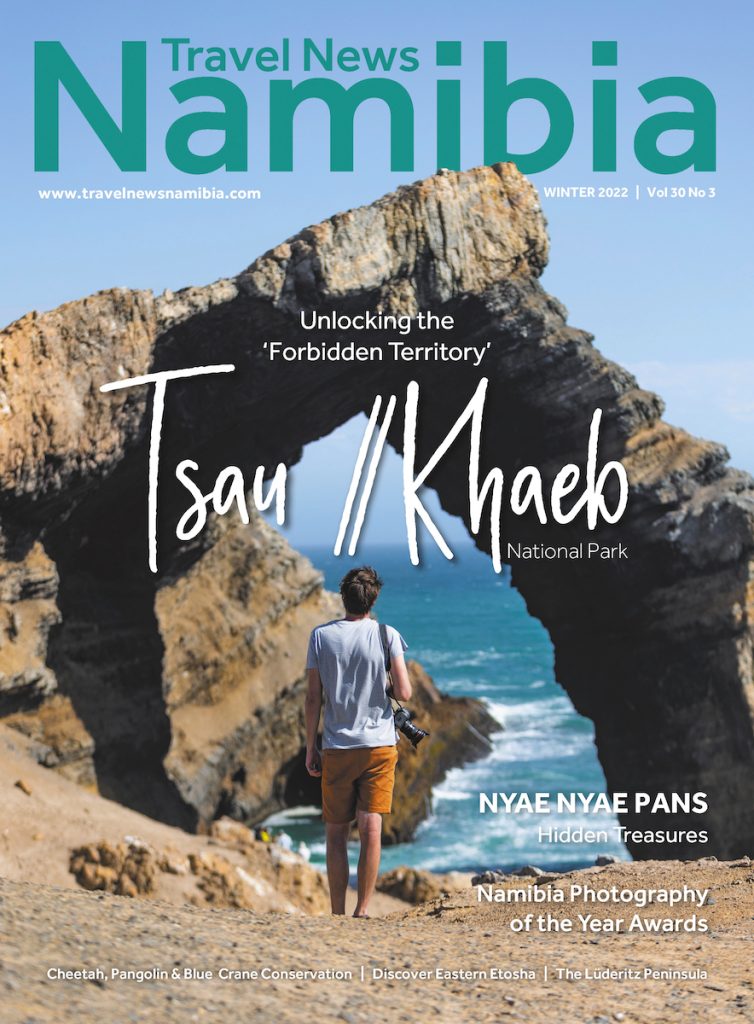

Fewer blue cranes than black rhino
Text & Photographs Dirk Heinrich
From the Winter 2022 issue
It was still very dry at the end of November 2021 in Etosha National Park, home to Namibia’s small and isolated blue crane population. A few good rain showers several weeks earlier triggered a migration from the Andoni plains north of Namutoni close to the King Nehale Gate, where all of Namibia’s blue cranes seem to have congregated, towards the Fischer’s Pan area. Four of the 19 birds moved, but that number appears to have changed again since one pair returned to the Andoni waterhole after a short visit.
The 2021 summer count took place from the 20th to 27th of November. We visited various sites where blue cranes had been observed in the past, but only found one pair on the plains of Fischer’s Pan east of Namutoni, another pair at Twee Palms waterhole and 15 birds at the Andoni waterhole.
Although there had been some rain in Etosha National Park during the first half of the 2021/22 rainy season, it was very dry and hot. The blue cranes have not moved to breeding areas like Charitsaub and Koinachas as they had in November 2018. Back then, the pair marked with engraved colour rings NHF and NHH was recorded at Charitsaub and NBZ was seen with an unmarked partner at Koinachas.
We visited Andoni waterhole on the 21st, 23rd and 25th of November 2021 and counted 15, 14 and 17 blue cranes on the respective days. On the 25th we saw two blue cranes a few kilometres east of Namutoni but none at Twee Palms. We believe that the pair at Twee Palms moved back to Andoni waterhole because it was too dry and unfavourable at Twee Palms.
At the Andoni waterhole the two immature birds A1 and A2, which we ringed as chicks near Namutoni in April 2021, were spotted on all three visits, as well as the four young birds equipped with transmitters. Three of the cranes with leg transmitters have metal and colour rings. NAT (metal ring: A15875) and NAV (9A15874) were both ringed at Fischer’s Pan in May 2020, and NEV (9A15719) in April 2020 at Halali Seepage. NAV was unfortunately found dead in June 2020 with a broken leg. Two chicks were fitted by an MEFT official with transmitters in May last year, one receiving a transmitter and the colour ring NAV which had been taken off the dead chick the year before. The other bird was only fitted with a transmitter on his right upper leg.
Two of the immature birds seemed to be the chicks from Halali Seepage that could not be ringed in April last year because they were too big already – they were able to fly and thus could not be caught. They were amongst the group at Andoni too. It is alarming that eight of the 19 birds tallied in the past summer count are this year’s (six) and last year’s (two) youngsters, leaving only 11 adult birds in Namibia’s blue crane population!
Of the eleven adult birds only NHH (9A15641), ringed in March 2007 near Salvadora waterhole, NCN (9A15701), ringed near Halali Seepage in April 2016 and NHD (9A15864), ringed in April 2006 in the plains east of Rietfontein, could be identified. NHD’s green plastic ring with white letters is broken and will most probably fall off the leg soon, making it more or less impossible to identify the bird in future since one is not able to read the numbers on the metal rings from a distance. In the group was an adult with a metal ring only, which could not be identified. The rest of the birds are unmarked.
According to unconfirmed reports the Namibian blue crane population is seriously threatened because of poaching. The birds are killed and eaten once they leave the safety of Etosha National Park to feed in the Lake Oponono area further north. Some serious investigation and education need to be done to try and save Namibia’s small and isolated blue crane population.
Hanjo Böhme, the principal coordinator of the Namibia Crane Working Group, is convinced that if nothing drastic is done immediately, Namibia’s blue cranes will be extinct in three to five years. In the 1970s, more than 100 blue cranes inhabited Etosha National Park and the neighbouring Omadhiya Lake area (1976: 138). In December 1994, there were only 60 of these rare birds left and in recent years the number has varied between 30 and 35 individuals (adults and chicks). During the 2018 summer count 27 birds were recorded in Etosha National Park and in 2019 only 13.
We have far fewer blue cranes left in Namibia than black rhinos. A small, isolated group of blue cranes is found in central northern Namibia, a few isolated birds in Botswana and eSwatini (former Swaziland) and an estimated population of 25000 birds in South Africa. All populations are decreasing, and the main factor seems to be habitat loss.
Since 2006 a total of 37 blue cranes have been ringed in ENP. At the moment four birds are fitted with satellite transmitters. Only eight ringed birds are still sighted, and one with only a transmitter.





